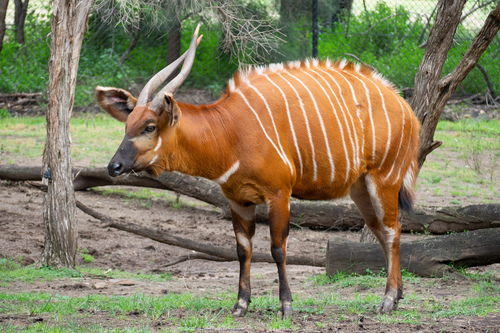
Bongo
The bongo, a vibrant forest antelope with distinctive white-striped, reddish coats and spiraled horns, thrives in Africa's dense rainforests. These elusive, nocturnal creatures help sustain their habitat by dispersing seeds, uniquely blending beauty and ecological importance.
10-18 years
Lifespan
227.0 - 408.2 kg
Weight
Length: 1.7 - 2.5 m
Size
Brown, Red, Black, White, Orange, Chestnut
Color
20-24 months
Age of Sexual Maturity
6 months
Age of Weaning
43 mph
Top Speed
Near Threatened
Conservation Status
Decreasing
Population Trend
Characteristics
Tragelaphus eurycerus, commonly known as the bongo, is a large forest antelope native to the dense rainforests of Central and West Africa. Distinguished by its striking reddish-brown coat, adorned with white stripes, bongos possess long, spiraled horns, which are present in both males and females. They exhibit nocturnal behavior, feeding on leaves, bushes, and grasses, and play a vital role in seed dispersal within their ecosystem.
Distribution Range of the Bongo
Tragelaphus eurycerus, commonly known as the Bongo, is native to the dense forests of central and western Africa. Its geographical distribution includes countries such as Cameroon, Central African Republic, Congo, Democratic Republic of the Congo, Gabon, and parts of Kenya.
Bongo's Habitat
Environmental Conditions
The Bongo inhabits tropical rainforest regions that are characterized by dense vegetation and a humid climate. These areas typically have a high annual rainfall and a warm, stable temperature range. The Bongo prefers areas with thick underbrush, which provide ample cover from predators and abundant food sources.
Ecological Niche
The Bongo is primarily a browser, feeding on leaves, bushes, vines, bark, grasses, and roots. It plays a crucial role in its ecosystem by aiding in seed dispersal through its diet. Bongos are mostly nocturnal and crepuscular, meaning they are most active during the night and twilight hours, which helps them avoid predators and human activity.
Copyright @ Nature Style Limited. All Rights Reserved.
 English
English